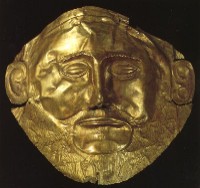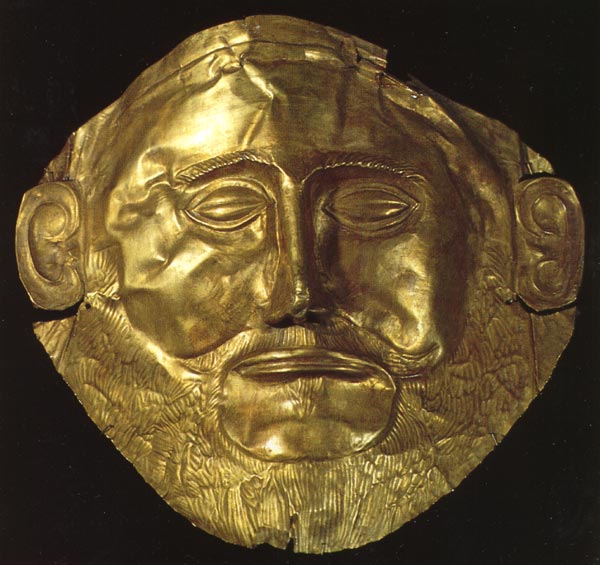'Agamemnon' mask
Mycenae, 16th century a.e.v.
National Archaeological Museum, Athens

- CAPTION
- 'Agamemnon' mask, mycenaean.
- Mycenae, tomb V.cA.
- 16th century a.e.v.
- Athens National Museum Inv.No.624.
- FOUND at LOCATION: Mycenae (MAP)
- RELATED: Homeric world. Heinrich Schliemann @wikipedia, Agamemnon @wikipedia.
- TEXT-COMMENTS: source: 'Polychrysae Mycenae' Mosaic. Houghton & Mifflin. retr:1999.10, 2007:obsolete.
Polychrysae Mycenae (Rich in Gold) is how Homer described the main citadel of the Mycenaean Greeks. Until Heinrich Schliemann excavated the site in 1876 there was no evidence to substantiate Homer's claim. Schliemann discovered five grave shafts within the walls of the fortress which contained the bodies of over twenty people and an abundance of gold, silver and bronze artifacts. Bronze swords and shields which closely approximate those described by Homer were also found in the grave shafts.
Schliemann optimistically described this artifact as the funeral mask of Agamemnon himself. It was found upon the face of the one of bodies within the grave shafts. Two other funeral masks were also discovered, each with distinctive features, which suggests that they were portraits of the deceased. While the masks and other exquisite artifacts within the tombs distinguish them as royal grave sites, more recent archaeological work has dated the shafts to the sixteenth century B.C., or three hundred years before the alleged life of Agamemnon. Despite this discrepancy, the relic is still known as the "Mask of Agamemnon." The finds at Mycenae establish the sophistication of Greek culture at the dawning of the Mycenaean era.
-

- PHOTO DATA: item in black background
- agamemnonMask_mycenae_AthensNM_1_200x188.jpg 14kb
- agamemnonMask_mycenae_AthensNM_1_600x565.jpg 61kb
- IMAGE SOURCE: 'Polychrysae Mycenae' Mosaic, Houghton & Mifflin. retr:1999.10. obsolete:2007.
- USED IN
- eng/history/topics/greek_history.htm
- eng/places/greece/athens_museums.htm
katerin sarri, athens, 2007. rev:2008.06.14.

